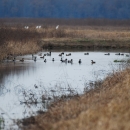About Us
Our Mission
ESTABLISHING AND ACQUISITION AUTHORITY:
- 16 U.S.C. 3901(b) Stat.3582-91(Emergency Wetlands Resources Act of 1986) • Sec. 305, P.L.104-33 (Omnibus Parks and Public Lands Act of 1996)
REFUGE PURPOSES:
- “ ...the conservation of the wetlands of the Nation in order to maintain the public benefits they provide and to help fulfill international treaty obligations contained in various migratory bird treaties and conventions.” 16 U.S.C. 3901(b) Stat.3582-91(Emergency Wetlands Resources Act of 1986)
- “...recognize the important public purposes served by non-consumptive activities, other recreational activities, and wildlife-related public use, including hunting, fishing and trapping.” Furthermore, this plan “ ...shall permit, to the maximum extent practicable, compatible uses to the extent that they are consistent with sound wildlife management, and in accordance with the National Wildlife Refuge System, Administration Act of 1997 (16 USC668dd-668ee) and other applicable laws.” (Omnibus Parks and Public Lands Act of 1996)
Our History
Pond Creek National Wildlife Refuge (NWR) is the 501st refuge to be established under the National Wildlife Refuge System. Itwas originally named Cossatot NWR in 1994, but was then changed in 1997 to retain the area's local name "Pond Creek Bottoms". The first 2,300 acres were acquired through a combination of donations and fee title purchases facilitated by The Conservation Fund. These initial lands were retained in a "caretaker" status until the passage of the Omnibus Parks and Public Lands Management Act of 1996 (Sec. 305, P.L. 104-333). This act facilitated the transfer of 25,000 acres of Weyerhaeuser Company land to the Service as part of the refuge, bringing the total acreage to 27,300. The act also required the Service to prepare a management plan for the new refuge.
Other Facilities in this Complex
A National Wildlife Refuge Complex is an administrative grouping of two or more refuges, wildlife management areas, or other refuge conservation areas that are primarily managed from a central office location. Refuges are grouped into a complex structure structure
Something temporarily or permanently constructed, built, or placed; and constructed of natural or manufactured parts including, but not limited to, a building, shed, cabin, porch, bridge, walkway, stair steps, sign, landing, platform, dock, rack, fence, telecommunication device, antennae, fish cleaning table, satellite dish/mount, or well head.
Learn more about structure because they occur in a similar ecological region, such as a watershed or specific habitat type, and have a related purpose and management needs. Typically, a project leader or complex manager oversees the general management of all refuges within the complex and refuge managers are responsible for operations at specific refuges. Supporting staff, composed of administrative, law enforcement, refuge manager, biological, fire, visitor services, and maintenance professionals, are centrally located and support all refuges within the complex.

